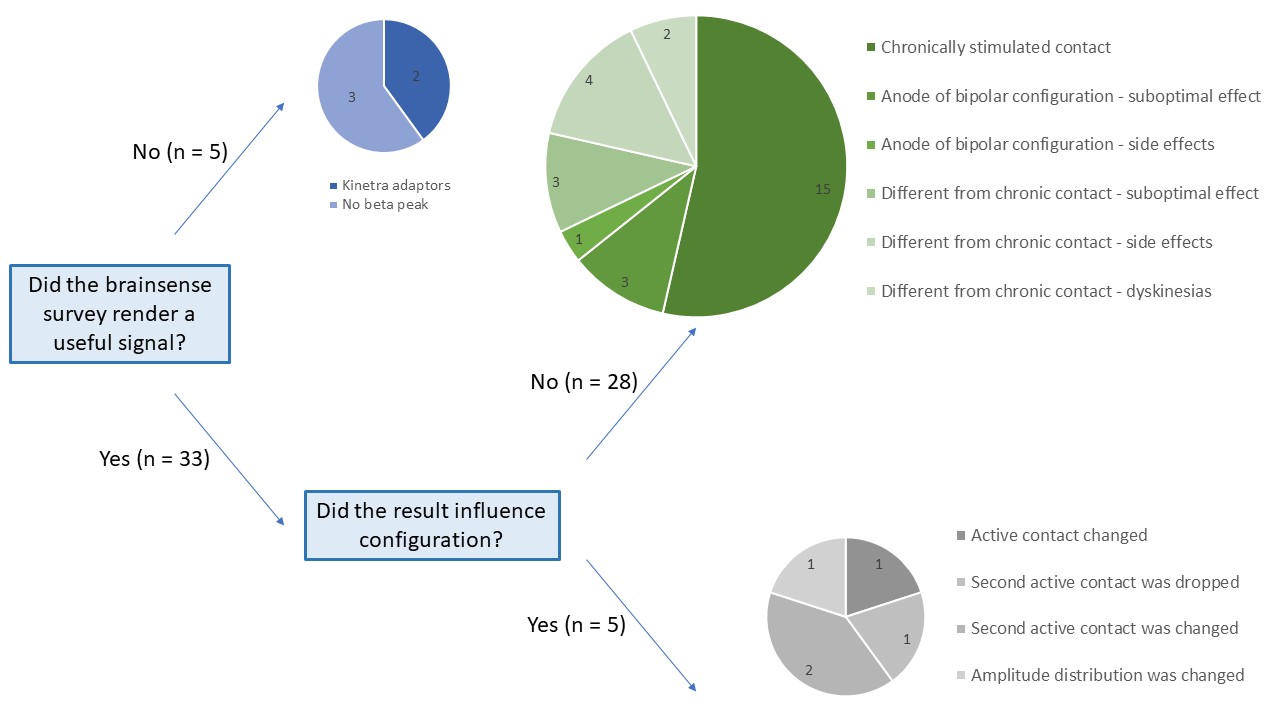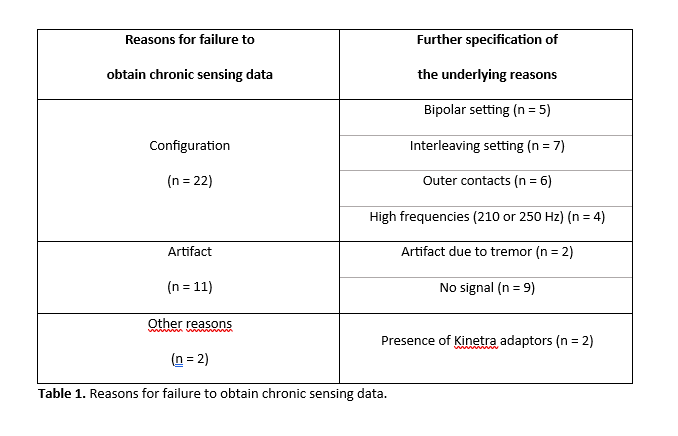Category: Surgical Therapy: Parkinson's Disease
Objective: To test the feasibility and usefulness of sensing features in patients undergoing replacement of their implantable pulse generator (IPG).
Background: People with Parkinson’s disease (PD) having fluctuating motor symptoms can be treated with deep brain stimulation targeting the subthalamic nucleus (STN DBS)1. One of the most recent innovations in the DBS field has been sensing, i.e. recording of local field potential (LFP) using the same lead used for stimulation2. Most studies on sensing are done in recently implanted patients. This study investigates whether LFP recordings can be obtained from chronically implanted patients and assesses the added value of these recordings.
Method: We recruited 19 PD patients (38 STNs) undergoing battery replacement surgery in whom the Activa PC was replaced with a Percept PC (Medtrzoronic, Minneapolis, MN, USA). Thereafter, the LFP spectrogram per contact pair (‘Brainsense Survey’) was completed to inform on the contact with the highest beta peak. We checked whether this corresponded to the chronically activated contact. If the contact did not correspond, the contact with the highest beta peak was activated and clinical effect compared to the chronically activated contact. Secondly, we tried obtaining streaming data (‘Brainsense Streaming’).
Results: Patients had an average disease duration of 16.4 (± 5.8) years and mean time since DBS of 6.5 (± 3.8) years. For 5 STNs, no useful data were obtained due to cable adaptors not allowing sensing (n = 2) or lack of beta peak (n = 3). For 28 STNs a signal was obtained but did not lead to configuration changes as in 15 STNs the contact with the highest beta peak corresponded to the chronic contact. In 13 STNs, configuration changes supported by the sensing signal led to inferior symptoms control or stimulation-induced side effects (Figure 1). In 5 STNs, the LFP spectrogram led to configuration changes that were permanent and resulted in a better outcome. Chronic sensing data could only be obtained in 3 STNs. Reasons for failure of data collection of chronic sensing are listed in Table 1.
Conclusion: In chronically stimulated patients, LFP spectrograms can readily be obtained. For most STNs the contact with the highest peak corresponded to the chronic contact. In 5/38 STNs, the beta peak led to a configuration change. Obtaining chronic recording was more difficult due to configurations not compatible for such recording.
Overview of spectrograms of individual STNs.
Reasons for failure to obtain sensing data.
References: 1. Deuschl G, Antonini A, Costa J, et al. European Academy of Neurology/Movement Disorder Society-European Section Guideline on the Treatment of Parkinson’s Disease: I. Invasive Therapies. Movement Disorders. 2022;37(7):1360-1374. doi:10.1002/mds.29066
2. Neumann WJ, Turner RS, Blankertz B, Mitchell T, Kühn AA, Richardson RM. Toward Electrophysiology-Based Intelligent Adaptive Deep Brain Stimulation for Movement Disorders. Neurotherapeutics. 2019;16(1):105-118. doi:10.1007/s13311-018-00705-0
To cite this abstract in AMA style:
A. Boogers, MB. Justich, M. Montiel, I. Alhashyan, S. Naghdlou, S. Kalia, A. Lozano, RP. Munhoz, A. Fasano. Feasibility and added value of sensing feature in patients with chronic STN DBS for Parkinson’s disease [abstract]. Mov Disord. 2024; 39 (suppl 1). https://www.mdsabstracts.org/abstract/feasibility-and-added-value-of-sensing-feature-in-patients-with-chronic-stn-dbs-for-parkinsons-disease/. Accessed April 1, 2025.« Back to 2024 International Congress
MDS Abstracts - https://www.mdsabstracts.org/abstract/feasibility-and-added-value-of-sensing-feature-in-patients-with-chronic-stn-dbs-for-parkinsons-disease/


